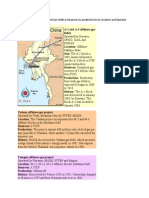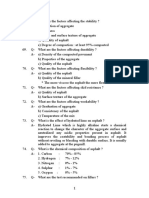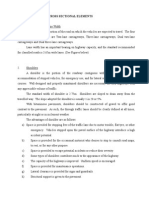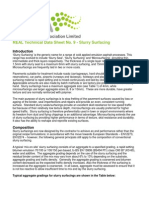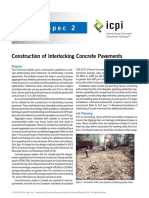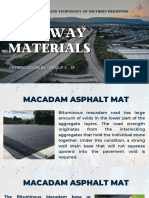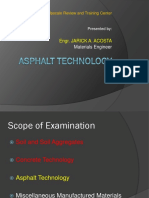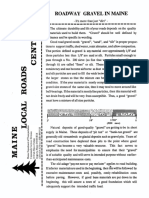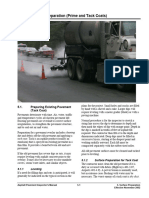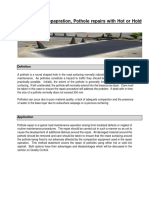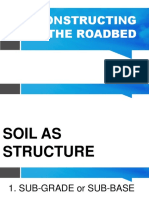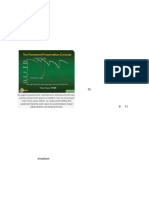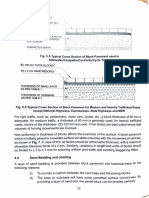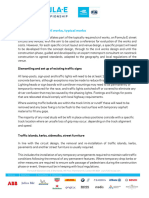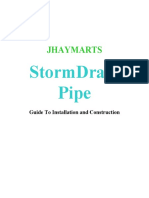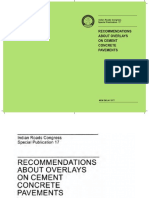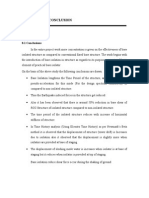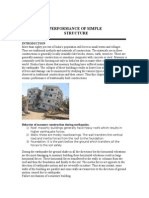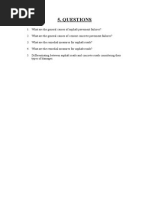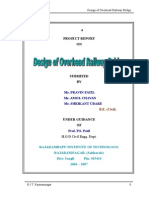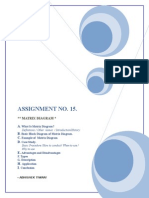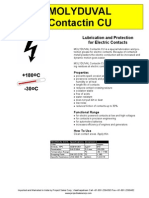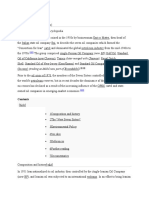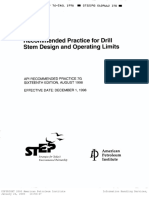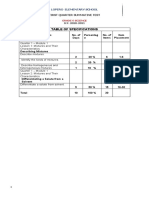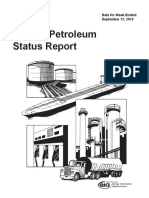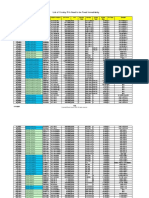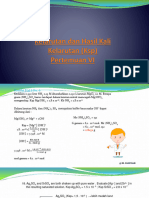0 ratings0% found this document useful (0 votes)
56 viewsRepairs of Asphalt Roads
Repairs of Asphalt Roads
Uploaded by
PradeepLokhande1. The document discusses various types of defects that can occur in asphalt roads including surface defects, cracks, deformation defects, and disintegration defects.
2. Surface defects include fatty surfaces, smooth surfaces, streaking, and hungry/dry surfaces which are caused by excess binder, soft grades of asphalt, and loss of aggregates. Cracks include hairline cracks, alligator cracks, longitudinal cracks, and edge cracks.
3. Deformation defects involve rutting, corrugation, shoving, and settlements due to heavy traffic loads, poor compaction, and weak pavement. Disintegration defects comprise of stripping, loss of aggregates, ravelling, and potholes caused by water
Copyright:
© All Rights Reserved
Available Formats
Download as DOC, PDF, TXT or read online from Scribd
Repairs of Asphalt Roads
Repairs of Asphalt Roads
Uploaded by
PradeepLokhande0 ratings0% found this document useful (0 votes)
56 views16 pages1. The document discusses various types of defects that can occur in asphalt roads including surface defects, cracks, deformation defects, and disintegration defects.
2. Surface defects include fatty surfaces, smooth surfaces, streaking, and hungry/dry surfaces which are caused by excess binder, soft grades of asphalt, and loss of aggregates. Cracks include hairline cracks, alligator cracks, longitudinal cracks, and edge cracks.
3. Deformation defects involve rutting, corrugation, shoving, and settlements due to heavy traffic loads, poor compaction, and weak pavement. Disintegration defects comprise of stripping, loss of aggregates, ravelling, and potholes caused by water
Original Description:
road design
Original Title
Asphalt
Copyright
© © All Rights Reserved
Available Formats
DOC, PDF, TXT or read online from Scribd
Share this document
Did you find this document useful?
Is this content inappropriate?
1. The document discusses various types of defects that can occur in asphalt roads including surface defects, cracks, deformation defects, and disintegration defects.
2. Surface defects include fatty surfaces, smooth surfaces, streaking, and hungry/dry surfaces which are caused by excess binder, soft grades of asphalt, and loss of aggregates. Cracks include hairline cracks, alligator cracks, longitudinal cracks, and edge cracks.
3. Deformation defects involve rutting, corrugation, shoving, and settlements due to heavy traffic loads, poor compaction, and weak pavement. Disintegration defects comprise of stripping, loss of aggregates, ravelling, and potholes caused by water
Copyright:
© All Rights Reserved
Available Formats
Download as DOC, PDF, TXT or read online from Scribd
Download as doc, pdf, or txt
0 ratings0% found this document useful (0 votes)
56 views16 pagesRepairs of Asphalt Roads
Repairs of Asphalt Roads
Uploaded by
PradeepLokhande1. The document discusses various types of defects that can occur in asphalt roads including surface defects, cracks, deformation defects, and disintegration defects.
2. Surface defects include fatty surfaces, smooth surfaces, streaking, and hungry/dry surfaces which are caused by excess binder, soft grades of asphalt, and loss of aggregates. Cracks include hairline cracks, alligator cracks, longitudinal cracks, and edge cracks.
3. Deformation defects involve rutting, corrugation, shoving, and settlements due to heavy traffic loads, poor compaction, and weak pavement. Disintegration defects comprise of stripping, loss of aggregates, ravelling, and potholes caused by water
Copyright:
© All Rights Reserved
Available Formats
Download as DOC, PDF, TXT or read online from Scribd
Download as doc, pdf, or txt
You are on page 1of 16
2.
REPAIRS OF ASPHALT ROADS
Bituminous material used for road surfacing may be broadly divided as:
1. Asphalt
2. Tar
Asphalt cement is a bituminous material that is produced by distillation of petroleum oil.
it may be further divided as petroleum asphalt or bitumen and native asphalt.
There are different forms in which native asphalts are available. Native asphalts are those
Which occur in a pure or nearly pure state in nature Native asphalts are associated with a
!arge proportion of mineral matter" called roc# asphalt.
The viscosity of asphalt is reduced sometimes by a volatile dilutent. This material is
called cutbac#. when asphalt is suspended in a finely divided condition in an a$ueous
medium and stabili%ed with an emulsifier it is called as emulsion.
.
Nearly all of &ndian surfaced road length which is about half of the total road length" has
asphalt surfacing. With the growing re$uirements of new construction and maintenance
of e'isting roads our annual consumption of asphalt has increased to about 1.( million
tones currently. Asphalt is used in the road bloc# in a variety of ways" ranging from thin
surfacing to high $uality surface courses.
The common binders used in asphalt road construction are road tar and bitumen. )oad tar
was used in &ndia up to about 1*(( for road construction purposes mainly because of its
greater availability as compared to
1
+roperties of asphalt are:
1. Asphalt is viscoelastic material that behaves as a li$uid at high temperatures and
as an elastic solid at low temperatures.
2. At pavement operating temperatures" asphalt cement has a semisolid
consistency.
,. The viscosity of asphalt varies with temperature. &t possesses characteristics
of adhesion with road aggregates.
-. )oad tar has better adhesion but is more susceptible to temperature than
asphalt. They get o'idi%ed and become brittle much $uic#er than asphalt thus
yielding reduced life of surfacing.
.ue to these properties asphalt is preferred over tar roads. /owever periodically
many defects may arise which can be repaired by following methods.
The types of defects on asphalt surface are grouped under four categories.
a. 0urface defects which include fatty surfaces" smooth surfaces" strea#ing and hungry1dry surface.
b. 2rac#s which covers hairline crac#s" alligator crac#s" longitudinal crac#s" edge crac#s" shrin#age
crac#s and )eflection crac#s.
c. .eformation defects which comprise of slippage" rutting" corrugation" shoving" shallow
depression and settlements.
d. .isintegration defects which consist of stripping" loss of aggregates" reveling" pot holes and edge
brea#ing.
The general caused and remedies for these defects are given in following paragraphs.
2
A. SURFACE DEFECTS
Correction of surface defect due
DEFECTS
CAUSES REPAIRS
Fatty
surfaces:
1. 3'cess binder.
2. 0oft grade of asphalt
,. Non uniform spraying and loss of
aggregates as in surface dressing.
-. /eavy a'le loads.
Apply hot dry cover aggregates or
sand and roll gently for removal of
e'cess binder. Burn it if necessary
or relay area affected.
Soot!
Surfaces:
1. +olishing of aggregates by traffic.
2. 3'cess binder.
)esurface with premi' carpet using
hard aggregates or with slurry seal.
,
Strea"in#
$a%ternate %ean
and ric! %ines
of as&!a%t in
surface
dressin#' in
%on#itudina% (
trans)erse
direction.
1. Non uniform application of binder
2. !ow temperature of binder.
,. 4anual spraying.
-. 4echanical faults during spraying.
Apply new surface dressing with
proper care in spraying of asphalt.
Hun#ry( dry
surfaces:
1. 5se of insufficient binder.
2. 5se of absorptive aggregates.
,. !oss of aggregates from surface
Apply slurry seal" or for emergency
repair applies fog seal.
*. CRAC+S
-
Hair%ine
crac"s
$fine crac"s at
c%ose inter)a%'
1. &nsufficient asphalt.
2. 3'cess filler.
,. 2ompacting when too hot.
-. 6ver compaction.
Apply fog seal with binder.
2ut7bac# binder or asphalt solution.
A%%i#ator
Crac"s
$inter,connect,
ted crac"s
forin#
-%oc"s'
1. 3'cessive movement of base or
sub7base layer.
2. base saturation" e'cessive loads over weathered
surfacing" inade$uate pavement
thic#ness.
8ill crac#s with asphalt emulsion or
cut7bac# binder apply slurry7seal
or sand7asphalt mi'" apply drainage.
Lon#itudina%
Crac"$at t!e
.oint -et/een
&a)eent and
s!ou%der or at
t!e .oint
-et/een t/o
&a)in# %anes'
1. 2ontraction or movement of
0ub grade beneath shoulder.
2. !ane 9oint crac# due to wea#
9oint or differential frost heave
along centre7line.
8ill and seal bac# with cut7bac#
binder or asphalt emulsion. Apply
sand asphalt mi' if crac#s are wider
than three mm.
Ed#e crac"s
$&ara%%e% to outer
ed#e of
&a)eent 0.1
to 0.2 inside'
1. !ac# of lateral support from shoulder.
2. +oor surface drainage.
,. Base saturation shrin#age.
-. 8rost heave
(. &nade$uate pavement width.
1.)ectify drainage system"
2.provide hard and paved shoulders"
,. fill crac#s and lay premi' carpet
with seal coat
-. if edge of the pavement has settled
bring it up to the desired grade with
plant mi' patching material.
(
S!rin"a#e
Crac"s
$trans)erse
direction or
interconnected
crac"s in
%ar#e -%oc"s'
1.0hrin#age of asphalt layer caused by
:olume change of asphalt mi' with high
2ontent of hard asphalt.
2. !ac# of traffic.
Apply slurry seal or sand asphalt
mi' for filling such crac#s.
Ref%ection
Crac"s
$usua%%y
o)er,%ays
o)er ceent,
concrete or -ad%y
crac"ed as&!a%t
a%t -ase.'
1..ue to 9oints and crac#s in the pavement
layer underneath.
1.8ill crac#s and seal suitably
depending on the si%e of crac#.
2.Apply a crac# relief layer for
prevention of such crac#s.
C. DEFOR3ATIO4 DEFECTS
;
S%i&&a#e$-et/een to& %ayer and
%ayer -e%o/
acco&anied -y
crescent s!a&ed
crac"s in
direction of
T!rust of /!ee%s'
1. !ac# of bond between layers due to
omission or inade$uacy of tac#7coat or
prime coat" dust or moisture in between
layers" heavy thrust by traffic
1. )emove affected area
2. Apply tact coat and patch with
premi'
Ruttin#
$%on#itudina%
De&ressions or
5roo)es in /!ee%
Trac"s'
1. /eavy channeli%ed traffic
2.!ow stability of mi' due to inade$uate
2ompaction
,. Wea# pavement
-./igh intensity of load stress as from
bulloc# carts.
(. +lastic deformation
1.8ill ruts with premi' carpet and
compact.
2.)elay affected portion with
asphalt mi' of good stability if
necessary.
Corru#ations$
Re#u%ar
Undu%ations
Causin# s!a%%o/
6a)y surface'
1. !ac# of stability in mi'
2. 3'cess binder1fines.
,. 0oft asphalt
-. +oor aggregate interloc#
(. oscillations set up by vehicles
;. 8re$uent brea#ing of vehicles
<. 8aulty laying of mi'
1. 0carify and relay the surface.
2. 2ut high spots and fill low spots
,. 5se heater planer to rectify
defects
<
S!o)in#
$&%astic o)eent
6it!in surface
resu%tin# in
%oca%i7ed -u%#in#
of surface8
occurrin#
coon%y at
-us sto&s8
intersections
1. !ac# of stability of mi'
2. 3'cess binder or fines
,. 0ofter grade of asphalt
-. !ac# of bond between layers
(. /eavy traffic with fre$uent bra#ing
;. 0harp negotiation of curves and gradients
1.)emove affected portion and
relay with premi' carpet and
compact.
=
*
S!a%%o/
De&ressions
$%oca%i7ed and
%iited in si7e
di&&in# a-out
22 or ore
-e%o/ desired
&rofi%e'
1. /eavier traffic
2. 0ettlement of lower pavement layers
,. +oor construction methods
1.8ill with premi' carpet and
compact to desired grade and profile
Sett%eent
$%ar#e %oca%i7ed
Deforation /!ic!
3ay or ay not
-e #enera%%y
fo%%o/ed -y e9tend,
si)e crac"s'
1. +oor compaction to fill
2. +oor drainage in lower layers
,. &nade$uate pavement thic#ness
-.8rost heave or swelling effect of moisture
on e'pansive soil.
3'cavate defective fill" reconstruct
under controlled conditions to
re$uired thic#ness" provide ade$uate
drainage" strengthen the pavement if
re$uired.
D. DISI4TE5RATIO4 DEFECTS
Stri&&in#
$%oss of ad!esion
-et/een -inder
a##re#ates in
&resence of /ater'
1. 0ofter grade of asphalt.
2. 0iliceous type of aggregates.
,. .ust and moisture on aggregates.
-. )ain soon after laying of surface.
5se anti7stripping agent in suitable
doses in case of siliceous aggregates"
use of proper grade of asphalt for
coating" provide ade$uate surface
drainage.
1>
Pot,!o%es
$-o/% s!a&ed !o%es
of )aryin# si7es on
surface and
e9tendin# to -ase
course resu%tin#
fro %oca%i7ed
disinte#ration'
1. +oor surface drainage.
2. !ocali%ed defects in asphalt mi'.
,. &nsufficient binder.
-. &nsufficient layer thic#ness.
1. 8ill pot holes with premi' carpet.
After cutting these to regular si%e
and applying tac# coat
2. 8ill deep pot holes wit asphalt
penetration macadam or
storable mi'.
Ed#e -rea"in#
$frayed ed#es'
1. &nfiltration of water.
2. 0oftening of foundation.
,. Worn out shoulders with insufficient
side supports.
-. &nade$uate thic#ness at edge.
)elay shoulders with good materials
and compact" provide ade$uate
drainage.
11
Loss of a##re#ates
$as in surface
dressin#'
1. Non7uniform spraying of binder.
2. .elayed spreading of aggregates.
,. Traffic soon after laying.
-. &nsufficient binder.
(. Ageing of binder.
Apply li$uid seal" fog seal or slurry
seal. )elay" if necessary with li$uid
seal with proper $uality of control.
*. SPECIAL *ITU3IOUS 3I:ES
The specification for special asphalt mi'es used for repairing purposes is given below.
A. LI;UID SEAL:
!i$uid seal consists of an application of li$uid asphalt ?paving asphalt" cut bac# asphalt or asphalt
emulsion@ and covering the same with aggregates. This is applicable for rectifications of defects li#e stripping"
loss of cover aggregates" ravelling etc.
+aving asphalt =>11>> or is to be used at the specified spraying temperature. 8or cold application" cut bac#
asphalt of )27, or 427, grade and asphalt emulsion of )0 or 40 grade are suitable. The $uantities of
materials are ta#en & proper proportions.
*. FO5 SEAL:
8og seal is a light application asphalt emulsion usually without cover aggregates. &t is used to increase
binder content of asphalt surface" to re9uvenate o'idi%ed and old surfaces" to fill crac#s and to prevent
ravelling. &t can also be used as an emergency treatment for hungry surfaces.
A slow setting asphalt emulsion is diluted with an e$ual amount of water and spread at the rate of
12
>.( to 1.> liter1s$. m. depending upon te'ture and dryness of the e'isting asphalt surface. The fog
seal sets in about ,> minutes. Traffic can be allowed in the road after the fog seal has set to a firm
condition and is not pic#ed up by traffic.
C. SLURR< SEAL :
0lurry seal is a mi'ture of fine aggregates" mineral filler and asphalt emulsion with water in order
to achieve a slurry constituency. The ingredient are mi'ed and spread evenly on asphalt surface to fill
crac#s" to repair raveled smooth or hungry surface" to rectify loss of aggregates" to re9uvenate o'idi%ed
and open te'tured old asphalt surface and to provide a s#id resistant surface.
D. SA4D *ITU3I4 3I: FOR PATCHI45
0and7asphalt mi' for patching consists of a mi'ture of fine aggregates and asphalt binder
used for rectifying defects li#e crac#s" slippage" corrugation" shoving shallow depressions and
raveling. The fine aggregates consists of a medium to course sand to fineness modulus of more
than 2.( or fine grit passing 1.< mm sieve and retained on 1=> micron sieve. The binder is paving
asphalt =>11>> or cut7bac# asphalt of 427, grade. The affected area is thoroughly cleaned and a
trac# coat with paving asphalt is applied at the rate of <.(#g or 1> #g per 1> s$.m respectively.
The sand asphalt mi' is prepared with >.>>;cu.m of fie aggregates and ;.= #g of paving asphalt
or =.2 #g of cut bac# asphalt and is laid in 1> s$.m and the area is rolled to fine finish.
E.CRAC+ RELIEF LA<ER
1,
0&3:3 0&A3
+3)23NT +A00&NB
& && &&&
<(mm
;,mm
(>mm
->mm
2>mm
1>mm
-.<(mm
2.,;mm
1(>micron
<(micron
1>>
*(71>>
7
,>7<>
,72>
>7,
7
7
7
7
7
1>>
7
,(7<>
(72>
7
7
>7(
7
>7,
7
7
1>>
<(7*>
(>7<7
7
=72>
7
>7(
7
The crac# relief layer is a part of a asphalt overlay over cement concrete surfacing or over
badly crac#ed asphalt surfacing meant for reducing reflection crac#ing. &t is a <.( cm thic#
layer of open7graded" hot7mi'ed asphalt macadam containing 2( to ,( percent
interconnecting voids. 6nly crushed aggregates are to be used in the asphalt mi'. Because
of large amount of interconnecting voids" this layer provides a medium" through which
differential movements of the underlying cement concrete slabs are not readily transmitted
to the upper asphalt layer The grading of aggregates recommended is as follows. The selection
of a particular grading depends upon availability of aggregates of appropriate si%es.
+aving asphalt ;>1<> or =>11>> is used at the rate of 1.( to ,.> percent by weight of mi'.
A tac# coat of hot asphalt is applied at the rate of < to 1> #g1s$.m. The hot asphalt mi' is laid by a
paver to proper grade and profile. This layer should be covered with a surface course s soon as
practicable.
F. STORA*LE ASPHALT 3I:
1-
0&3:3 0&A3
+3)23NT +A00&NB
& &&
2>mm
12.(mm
1>mm
-.<(mm
2.,;mm
;>>micron
,>>micron
1(>micron
<(micron
7
1>>
=>71>>
((7<>
,(7(>
1=72*
1(72,
=71;
-71>
1>>
=>71>>
<>7*>
(>7<>
,(7(>
1=72*
1(72,
=71;
-71>
0torable asphalt mi' consists of cut7bac# asphalt or asphalt emulsion" aggregates and
filler. 2ut7bac# asphalt or asphalt of 427, grade and medium setting asphalt emulsion are found
to be more suitable. These mi'es can be prepared in advance and used whenever necessary. This
type of patching mi'er can be used for repair of slippage" rutting" shoving" shallow depressions and
pot7holes. Traffic can be allowed when binder has sufficiently cured. The grading of aggregates to
be used as follows:
Brading & is to be used for filling up of shallow depressions1pot7holes" while grading 2 can
be used for filling deep depressions pot7holes.
The binder content will be - to ( per cent weight of the mi'. Width cut7bac# asphalt of
427, grade" the mi' can be stored for < to 1> days" but with cationic bitumen emulsion"
the mi' has to be laid within ; to = hours. &n addition" cut7bac# asphalt needs to be treated
with anti7stripping agent" while no such treatment is needed with cationic asphalt emulsion.
1(
1;
You might also like
- 2.1 PPT - Homogeneous and Hetero MixturesDocument60 pages2.1 PPT - Homogeneous and Hetero MixturesKristymel Queen CabugonNo ratings yet
- Method Statement For Concrete Topping (Ramp Slab)Document2 pagesMethod Statement For Concrete Topping (Ramp Slab)mikollim100% (4)
- V-Asphalt TEchnology PDFDocument43 pagesV-Asphalt TEchnology PDFStephen John ClementeNo ratings yet
- Pavement Analysis & DesignDocument11 pagesPavement Analysis & DesignLo0oVve100% (1)
- Failure of Foundation Due To EarthquakeDocument10 pagesFailure of Foundation Due To EarthquakePradeepLokhande100% (3)
- Classification of Crude OilDocument16 pagesClassification of Crude Oilnikhil100% (2)
- Steel Grades Equivalent TableDocument13 pagesSteel Grades Equivalent TableSudhir DwivediNo ratings yet
- A Small List of Operating Oil and Gas Fields in Myanmar by Production LevelDocument6 pagesA Small List of Operating Oil and Gas Fields in Myanmar by Production LevelNickAronNo ratings yet
- Asphalt EmulsionsDocument5 pagesAsphalt EmulsionsCharith LiyanageNo ratings yet
- Pavement Design SeminarDocument12 pagesPavement Design SeminarWayaya2009100% (3)
- Repairs of Concrete Roads: 1. Failure in Cement Concrete PavementsDocument10 pagesRepairs of Concrete Roads: 1. Failure in Cement Concrete PavementsPradeepLokhande100% (1)
- Italconsult Q3Document17 pagesItalconsult Q3FarhanNo ratings yet
- Ceg 307 - 2nd NoteDocument10 pagesCeg 307 - 2nd NoteChidi HenryNo ratings yet
- Design of Small Earth DamsDocument6 pagesDesign of Small Earth DamsErnst Otieno100% (1)
- Transpo ReportDocument39 pagesTranspo ReportMichelle JumawanNo ratings yet
- Q&a (Asphalt) 2Document12 pagesQ&a (Asphalt) 2haleem ullah khanNo ratings yet
- The Black Cementing Agent Known As Asphalt Has Been Used For Road Construction For CenturiesDocument9 pagesThe Black Cementing Agent Known As Asphalt Has Been Used For Road Construction For CenturiesDavid SmithNo ratings yet
- Lecture-9 (A) Canal LiningDocument19 pagesLecture-9 (A) Canal LiningSameer SaleemNo ratings yet
- Types of PavementsDocument9 pagesTypes of PavementsWawaChumelNo ratings yet
- CPWD Cube SpecificationDocument2 pagesCPWD Cube SpecificationkumarchemNo ratings yet
- Slurry Surfacing Data Sheet (REA)Document5 pagesSlurry Surfacing Data Sheet (REA)Andrei LupulNo ratings yet
- Lecture-10 Canal LiningDocument19 pagesLecture-10 Canal LiningTamour KhalilNo ratings yet
- Tech Spec 2 ConstructionDocument8 pagesTech Spec 2 ConstructionHuascar Medrano LazarteNo ratings yet
- Roadway MaterialsDocument68 pagesRoadway MaterialsBAGUIO RechelleNo ratings yet
- IRC 14-1977 Bitumen and Tar CarpetsDocument11 pagesIRC 14-1977 Bitumen and Tar CarpetsKarki2No ratings yet
- Chapter 8 Surface DressingDocument53 pagesChapter 8 Surface DressingPronab Kumar Das100% (1)
- Asphalt Technology - 1 PDFDocument97 pagesAsphalt Technology - 1 PDFIvy Rafanan PascuaNo ratings yet
- Maintaining Gravel Roads SpecsDocument7 pagesMaintaining Gravel Roads SpecsanbertjonathanNo ratings yet
- EdgeDocument4 pagesEdgeHazmi Bcool100% (1)
- Grasscrete: Cast Insitu Paving System Design and Specification GuideDocument23 pagesGrasscrete: Cast Insitu Paving System Design and Specification Guidemssrao1977No ratings yet
- Granular Pavements With Thick Asphalt SurfacingDocument4 pagesGranular Pavements With Thick Asphalt SurfacingIlham FeryantoNo ratings yet
- Primer Coating Prepation ProceadureDocument14 pagesPrimer Coating Prepation ProceadureMd Naveed AhmedNo ratings yet
- RoadDocument26 pagesRoadashfaqkhancivilNo ratings yet
- Handbook No 1 - DrainageDocument51 pagesHandbook No 1 - DrainageRusdee KamisNo ratings yet
- LIC 15 Pothole Repairs - METHOD STATEMENTDocument6 pagesLIC 15 Pothole Repairs - METHOD STATEMENTrazawujondaiNo ratings yet
- Ch7 Surface and Pavement Layer Selection GuideDocument6 pagesCh7 Surface and Pavement Layer Selection Guideelenia546No ratings yet
- Road LayersDocument6 pagesRoad LayersNecmi HocaNo ratings yet
- Constructing The RoadbedDocument156 pagesConstructing The RoadbedLyka Isabel Tan0% (1)
- Foundations On Expansive Soils-Dr.a.sreerama RaoDocument8 pagesFoundations On Expansive Soils-Dr.a.sreerama RaoHemanth KumarNo ratings yet
- Chip Seal Fact SheetDocument3 pagesChip Seal Fact SheetBeowulf BrowerNo ratings yet
- Worktips16 Reinstatement PDFDocument2 pagesWorktips16 Reinstatement PDFjoebriffaNo ratings yet
- FINAL Hot Mix Asphalt May 2011.Pdft80Document6 pagesFINAL Hot Mix Asphalt May 2011.Pdft80jjrelucio3748No ratings yet
- Design Principle of Gabion Retaining WallDocument11 pagesDesign Principle of Gabion Retaining WallAbhilash AbhiNo ratings yet
- Chippings For Surface Dressings Note03Document2 pagesChippings For Surface Dressings Note03CarolNo ratings yet
- Tack CoatsDocument4 pagesTack CoatsWangTF100% (1)
- Asphalt FailuresDocument15 pagesAsphalt Failureshamdi moussaNo ratings yet
- CHIP SEAL Handout PDFDocument1 pageCHIP SEAL Handout PDFIssam SembatiNo ratings yet
- Chip Seals Process Design OverviewDocument3 pagesChip Seals Process Design OverviewAriel VargasNo ratings yet
- Paver Block DrainageDocument3 pagesPaver Block DrainageSHABANNo ratings yet
- Basics of Good Road 0Document4 pagesBasics of Good Road 0mehdiNo ratings yet
- Prime CoatDocument4 pagesPrime CoatAnonymous YHcvra8Xw6No ratings yet
- GitDocument107 pagesGitSiva VadeNo ratings yet
- Crack RepairDocument16 pagesCrack RepairMario Alberto Perez Mosos100% (1)
- CE 16 Last PushDocument3 pagesCE 16 Last PushBRONIEXXNo ratings yet
- Pavement Evaluation PaperDocument14 pagesPavement Evaluation Paperbehzad afridiNo ratings yet
- Recommended Practice 2 CM Thick Bitumen and Tar Carpets: (Second Rev/S/On)Document11 pagesRecommended Practice 2 CM Thick Bitumen and Tar Carpets: (Second Rev/S/On)Milind GuptaNo ratings yet
- 01-Peraturan FiaDocument8 pages01-Peraturan FiaEri Susanto HariyadiNo ratings yet
- Installation Guid For StormDrain PipeDocument6 pagesInstallation Guid For StormDrain Pipemanny valgunaNo ratings yet
- Concrete Construction Article PDF - Slip-Form PavingDocument3 pagesConcrete Construction Article PDF - Slip-Form PavingIbtissam ZahidNo ratings yet
- IRC SP 17-1977 Recommendations About Overlays On Cement Concrete PavementsDocument35 pagesIRC SP 17-1977 Recommendations About Overlays On Cement Concrete Pavementsjitendra100% (1)
- Earth RoadDocument6 pagesEarth Roaddemoz asfawNo ratings yet
- Sewage Disposal Works: Their Design and ConstructionFrom EverandSewage Disposal Works: Their Design and ConstructionNo ratings yet
- Fresco Painting - Modern Methods and Techniques for Painting in Fresco and SeccoFrom EverandFresco Painting - Modern Methods and Techniques for Painting in Fresco and SeccoNo ratings yet
- Literature Review: 2.1 OverviewDocument6 pagesLiterature Review: 2.1 OverviewPradeepLokhandeNo ratings yet
- Ground Improvement Technique-1Document13 pagesGround Improvement Technique-1PradeepLokhandeNo ratings yet
- Faculty Profile Format AICTEDocument1 pageFaculty Profile Format AICTEPradeepLokhandeNo ratings yet
- Key Words-Base Isolation, Base Isolated Structure Design, Earthquake DesignDocument2 pagesKey Words-Base Isolation, Base Isolated Structure Design, Earthquake DesignPradeepLokhandeNo ratings yet
- Chapter 4 Comparision of Simple and Base Isolated StructureDocument1 pageChapter 4 Comparision of Simple and Base Isolated StructurePradeepLokhandeNo ratings yet
- 3 Theory of Base IsolationDocument10 pages3 Theory of Base IsolationPradeepLokhandeNo ratings yet
- Chapter 4 Conclusion: 8.1 ConclusionsDocument2 pagesChapter 4 Conclusion: 8.1 ConclusionsPradeepLokhandeNo ratings yet
- Chap 9Document1 pageChap 9PradeepLokhandeNo ratings yet
- CHAP10Document2 pagesCHAP10PradeepLokhandeNo ratings yet
- Performance of Simple StructureDocument6 pagesPerformance of Simple StructurePradeepLokhandeNo ratings yet
- Chapter 4 Performance of Base Isolated Structure: Why Base Isolation Is Effective?Document8 pagesChapter 4 Performance of Base Isolated Structure: Why Base Isolation Is Effective?PradeepLokhandeNo ratings yet
- Fibre Reinforced ConcreteDocument12 pagesFibre Reinforced ConcretePradeepLokhande100% (2)
- QuestionsDocument1 pageQuestionsPradeepLokhandeNo ratings yet
- Geopolymer ConcreteDocument43 pagesGeopolymer ConcretePradeepLokhandeNo ratings yet
- Concrete BasicsDocument27 pagesConcrete BasicsPradeepLokhandeNo ratings yet
- Implosion of StructureDocument9 pagesImplosion of StructurePradeepLokhandeNo ratings yet
- Cracks in ConcereteDocument37 pagesCracks in ConceretePradeepLokhandeNo ratings yet
- A Project Report ON: Mr. Pravin Patil Mr. Amol Chavan Mr. Shrikant UbareDocument84 pagesA Project Report ON: Mr. Pravin Patil Mr. Amol Chavan Mr. Shrikant UbarePradeepLokhandeNo ratings yet
- Assignment No. 15.: Matrix DiagramDocument14 pagesAssignment No. 15.: Matrix DiagramPradeepLokhandeNo ratings yet
- Biogas PlantDocument42 pagesBiogas PlantPradeepLokhande100% (1)
- Mit (T) Aurangabad: Certificate (Dos - 5)Document1 pageMit (T) Aurangabad: Certificate (Dos - 5)PradeepLokhandeNo ratings yet
- Assignment No. 8.: BrainstormingDocument7 pagesAssignment No. 8.: BrainstormingPradeepLokhandeNo ratings yet
- Assignment No - 7.: Control ChartDocument7 pagesAssignment No - 7.: Control ChartPradeepLokhandeNo ratings yet
- Coarse DispersionsDocument14 pagesCoarse DispersionsTejas PatelNo ratings yet
- Temp Resis ChartDocument1 pageTemp Resis ChartBhushan KalgaonkarNo ratings yet
- Contactin CUDocument1 pageContactin CUProject Sales CorpNo ratings yet
- Bitumen Emulsion Rates 01.11.2016Document8 pagesBitumen Emulsion Rates 01.11.2016karunamoorthi_p2209100% (1)
- OPEC and The Seven SistersDocument2 pagesOPEC and The Seven SistersrioesvaldinoNo ratings yet
- 4 - Liquid Asphalt Grading SystemsDocument13 pages4 - Liquid Asphalt Grading Systemssora maytaNo ratings yet
- API GravityDocument3 pagesAPI GravityKamilah HarumasariNo ratings yet
- Seven SistersDocument5 pagesSeven SistersMursid SispamuntraNo ratings yet
- Oil & Gas Industry in Libya 2Document36 pagesOil & Gas Industry in Libya 2Suleiman BaruniNo ratings yet
- RP 7G Rev16 Drill StemDocument157 pagesRP 7G Rev16 Drill Stembiyoga anantoNo ratings yet
- PRES FlinthillsDocument12 pagesPRES Flinthills김도연No ratings yet
- 1st Quarter Test in Science 6 With Tos and Key To CorrectionDocument7 pages1st Quarter Test in Science 6 With Tos and Key To CorrectionYolly Millares100% (1)
- Summ. Test GR, 6 2020Document8 pagesSumm. Test GR, 6 2020jenilyn50% (2)
- Major Upcoming Upstream Projects NigeriaDocument1 pageMajor Upcoming Upstream Projects NigeriaZvonko BosnjakNo ratings yet
- Paraffin CairDocument1 pageParaffin CairInkNo ratings yet
- Grade Library NITONDocument2 pagesGrade Library NITONKande RameshNo ratings yet
- EIA Oil Weekly ReportDocument62 pagesEIA Oil Weekly ReportSalem SaeedNo ratings yet
- Raised Pedestrian Crossings - Cost ComparisonDocument1 pageRaised Pedestrian Crossings - Cost ComparisonMartinNo ratings yet
- Bitumen Rate Wef 01.06.21Document1 pageBitumen Rate Wef 01.06.21कुमुद पाठकNo ratings yet
- Project On ColloidsDocument10 pagesProject On ColloidsVipul Verma50% (6)
- Equivalencia Astm Materiales PipingDocument2 pagesEquivalencia Astm Materiales PipingJose Diaz100% (1)
- SPESIFIKASI Almg3Document6 pagesSPESIFIKASI Almg3Kawkab MustofaNo ratings yet
- Learning About The of Nghi Son Refinery: Rude Istillation NitDocument17 pagesLearning About The of Nghi Son Refinery: Rude Istillation NitTrường Tùng LýNo ratings yet
- Brochure KS-SE2Document6 pagesBrochure KS-SE2Mudzakkir AbduhNo ratings yet
- List of Crosby Rvs Need To Be Fixed ImmediatelyDocument6 pagesList of Crosby Rvs Need To Be Fixed ImmediatelyEr Bishwonath ShahNo ratings yet
- KSP 6Document8 pagesKSP 6MICHAEL LAWRENCENo ratings yet







